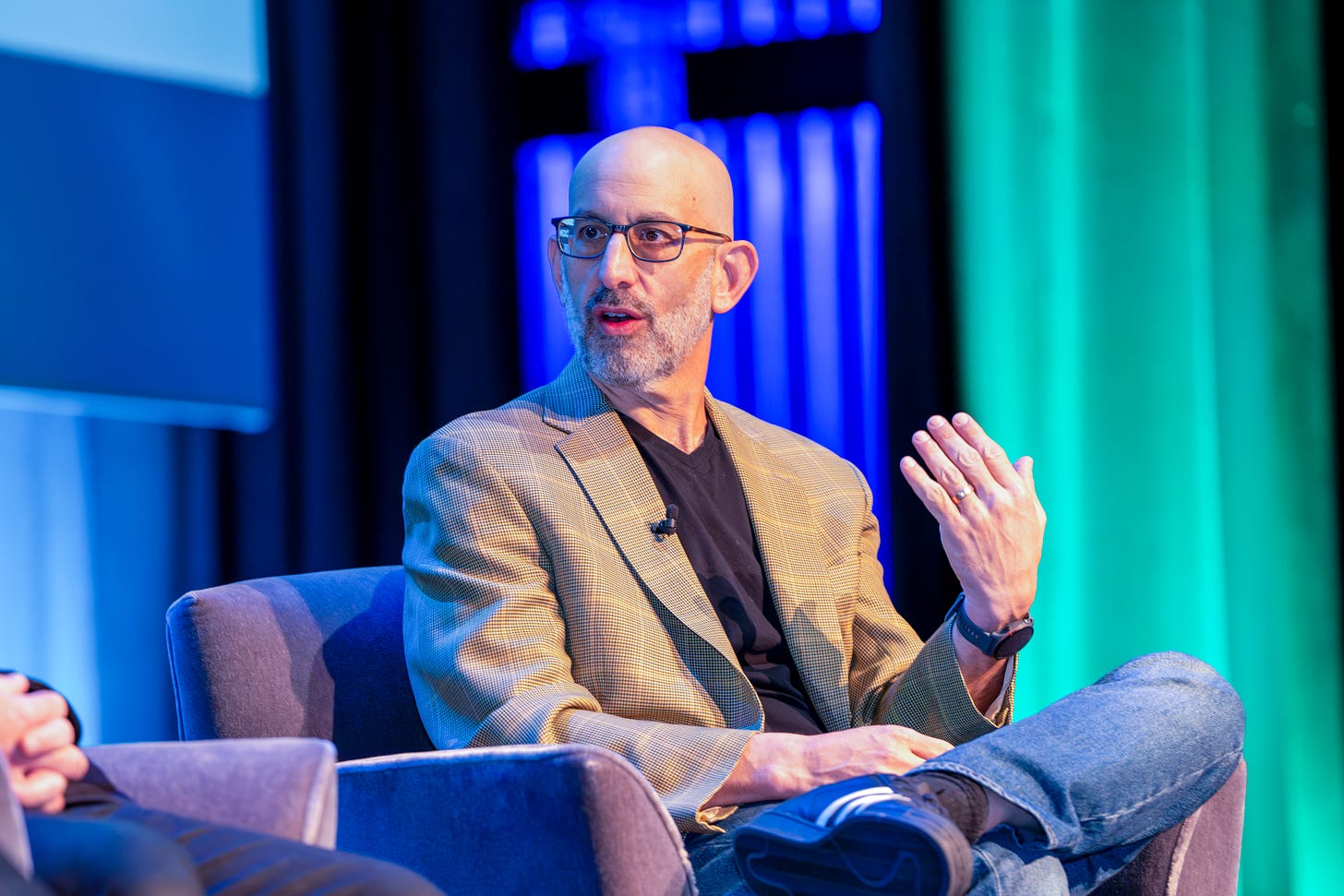I participated on the 2023 Mid Atlantic Marketing Summit keynote panel last autumn.
It’s been a year since I started Generative Buzz, an AI company for marketing professionals. More than halfway through, I joined forces with No Brainer Podcast co-host Greg Verdino, and we re-launched CognitivePath. Together, we developed a value proposition to serve enterprises, trade associations, and marketing organizations with a business solutions strategy approach to AI. Over the past year, this journey has produced five major takeaways about the AI boom.
First, a little background information: My involvement in the AI field predates starting Generative Buzz. Before this venture, I was a VP of marketing for Evalueserve, an international professional services company renowned for its analytics and domain-specific AI solutions. I also wrote about marketing AI solutions as early as 2018 (archives available here on Substack).
OK, let’s get into it. Here are the lessons learned.
1) AI is a team sport
A team of friendly robots (made with Midjourney).
Serving the marketing department was a natural progression for me. I have spent most of my career working in marketing departments or selling solutions to them. However, it became crystal clear that marketing alone was an unlikely customer for AI systems that are more impactful than generative AI subscription tools such as ChatGPT, Stable Diffusion, and Jasper.
Implementing a use case requiring significant customization or using company-specific data requires a much wider team, including the CTO (or CIO) team, legal, HR, and often the core executive team. Frankly, given how CMOs and marketing executives are already under fire and the lack of clarity surrounding AI solutions, many are unwilling to risk initiating an enterprise-grade AI project and seek the necessary political alignment. Instead, they are comfortable dabbling with personal productivity and creative solutions.
Those marketers and executives who want to do more know that AI is a team sport and work with their peers to identify and implement AI use cases that will most impact the enterprise or association’s goals. They understand the importance of ensuring data security, resourcing technical talent, and creating strong governance policies.
In the early days of the AI era, it’s important to acknowledge that the entire C-suite decides to initiate significant implementations.
2) Data is the big hurdle
Once companies and associations begin the AI exploration process, they must determine which data sources are necessary to fuel their AI model. Evaluating data integrity — whether structured or unstructured, internal or external — becomes the first step. Then, decisions need to be made. Project leads must prioritize cleaning, sourcing, and procuring data to ensure AI has the fuel it needs to generate informed predictions and content.
It’s not uncommon for enterprises and associations to pause AI efforts and focus on data governance and unification projects. They realize they lack the foundation to deploy a strong AI model that will generate meaningful outcomes. AI problems are often data problems: Garbage in, garbage out.
3) Overpromise is what Silicon Valley produces
Elon Musk enjoying a cup of coffee with an android (made with Midjourney).
Many enterprises are reticent to wholeheartedly embrace the AI era and with good reason. The hype wave manufactured by Silicon Valley companies and luminaries overwhelms the mind and underdelivers in results. Unfortunately, that hype wave goes beyond just the promises of individual systems. It also includes dystopian views that AI will replace 95% of whole professions or the entire workforce.
While the amazement most of us experienced when we used an LLM for the first time is undeniable, constant hype-fueled news creates immense cultural drag. In turn, greater uncertainty and fear about AI slows enterprise adoption.
Silicon Valley companies release AI technologies without an end user or a particular result in mind. Hidden costs of enterprise AI solutions are buried behind subscriptions for individual licenses. Top AI players have favored unrelenting product roadmap announcements without ironing out privacy and other ethics concerns or the potential impacts on a brand that deploys their solutions.
The list of ills could continue., but why bother? Silicon Valley has not learned from past unrealized hype bubbles such as the metaverse and Web3. When frivolous attention matters more than pragmatic outcomes, businesses pause to vet the realistic value of such technologies.
AI tools that execute tasks for humans remain one of the most pivotal technological evolutions in my lifetime. However, successful implementation requires discipline with pragmatic scoping and a laser focus on results. The best thing for any AI player – whether they be an algorithm provider, a supporting technology company, or a professional services consultancy – can do is focus on delivering accurate results that impact the bottom line.
For those who continue fueling the hype? Their credibility is on the line.
4) Most talk big and play smaller
AI stories are often larger than reality (made with Midjourney).
Similarly, many who claim to be executing AI tasks on a grand scale across their enterprise or for their clients might just be doing that. But more often than not, when you pull the curtains back, their implementations are often as simple as using ChatGPT or a limited enterprise license for Office 365 Copilot, Jasper, or an LLM platform. In other cases, their use case is simply using their now AI-enabled enterprise platform, such as GitHub, Adobe, or another platform.
These solutions are easier to vet with IT and legal thanks to the vendors guaranteeing their safe use. All of these are legitimate uses of AI, but they are still limited use cases predetermined by off-the-shelf vendors. Still, they are not the big impactful implementations some large organizations invest in to achieve their missions. It’s helpful to discuss use cases and results to determine an organization’s AI maturity.
5) We should look to social networking
Many concerns about generative AI, from a societal and business impact, mirror those of the social media era. From the ethics of use to the likelihood of the platform destroying entire industries (journalism, for example), social networking was unleashed on the Internet with little thought for impact. Once algorithms (hello AI) were deployed to fuel engagement and served ads, human controls about what content could be seen and consumed were sacrificed.
Now that the shine is off, we see social networking has had massive negative consequences, from teenagers’ (and adults’) self-image crises and privacy exploitation to digital literacy challenges and a new rise of absolutist tyrannical governments and politicians.
Wide swaths of journalists have lost their jobs. While some news organizations survived and thrived, news quality is not the same. The sensational headline and story win the day with social networking algorithms, ensuring users consume bombastic, out-of-context statements and videos. News outlets have responded with content that fuels algorithmic engagement. Look at sports and the rise of “anchors” like Pat McAfee.
How will big tech cos, their large business clientele, and, yes, governments use AI to achieve their goals? Just look at the morass OpenAI has become; it’s hard to feel good about the outcome if Sam Altman is left to determine our collective AI fate.
We don’t want the same result we had with social networking. The time to have conversations about industry standards and, yes, governance is now. Unfortunately, at least in the United States, we will likely punt the impacts down the road and leave regulation to other governments across the globe.
Those are my five takeaways from year one as an “AI Entrepreneur.” What insights might you add?







